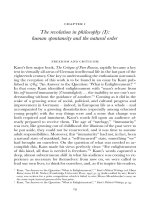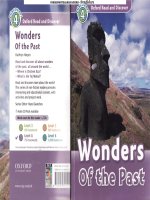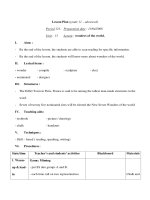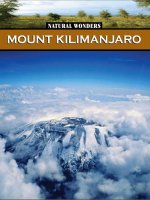natural wonders the everglades
Bạn đang xem bản rút gọn của tài liệu. Xem và tải ngay bản đầy đủ của tài liệu tại đây (8.8 MB, 31 trang )
Contents
A River of Grass 4
A Trip Back in Time 6
Changing the Flow 8
Everglades Ecosystems 10
A Park in Danger 12
Animals on the Brink 14
The Big Picture 16
People of the Everglades 18
A Natural Heritage 20
Natural Attractions 22
Key Issues: Water Conflicts 24
Time Line 26
What Have You Learned? 28
Find Out for Yourself 30
Glossary/Index 32
A River of Grass
Ö
magine a river of grass teeming with wildlife. This watery wilderness
is the Everglades. It is the largest marsh in the United States. Everglades
National Park was the first national park dedicated to protect wildlife. It is
the only subtropical preserve in North America and the only everglades in
the world.
The Everglades began to form at the end of the last Ice Age, about
10,000 years
ago.
As the ice melted, a shallow sea flooded the southern
part of Florida.
Today, the Everglades is a popular place for tourists to visit. If visitors are
lucky, they might spot a rare species, such as the Florida panther or the
West Indian manatee.
Everglades National Park spans the southern tip of Florida.
Everglades Facts
•
The
Everglades includes 5,000 square
miles
of
land
and
water—about
the
same size as
the
state
of
Connecticut.
•
The
average width ofthe Everglades
is
50
miles.The average depth
of the
water
is
only
6
inches.
• More than
400
species
of
birds have
been identified within
the
park.
•
The
Everglades
is the
only place
in the
world where alligators and crocodiles
exist together.
• Everglades National Park is
the
largest national park east
of the
Rocky Mountains.
• Everglades National Park
has
been named a World Heritage
Site,
an International Biosphere
Reserve,
and a Wetland
of
International Importance.
The Everglades Locator
0
Florida
Everglades
100 Miles
0 100 Kilometers
Natural Wonders
A Trip Back in Time
H
n ancient sea covered the southern Florida peninsula 6 million
years ago. The remains of plants and animals on the seafloor slowly
turned into limestone. This formed the bedrock ofthe Everglades. This
porous rock is called "egg-stone" because it looks like tiny fish eggs.
Glaciers did not reach southern Florida during the last Ice Age. As the
melting ice returned to the sea, however, it helped shape the Everglades.
The land was covered by water and dried out four times. Each time the
land was covered, more rocks formed.
a The Everglades contain thousands of islands. Most are actually clumps of
mangrove
trees,
a tropical tree with many roots.
The Everglades 7
rf
Salt water borders much of the Everglades, affecting the
community of plants and animals living in southern Florida.
From north to south, which U.S. states border the Atlantic
Ocean on the East Coast, and which border the Pacific Ocean
on the West Coast?
500 Miles
500 Kilometers
8 Natural Wonders
Changing the Flow
Q
or thousands
of
years,
the
overflow from Lake Okeechobee
has
supplied
the
Everglades with fresh water. Wide
but
shallow,
the
Everglades becomes salty
as it
nears Florida Bay
and the
Gulf of
Mexico. Humans have altered
the
course
of
this water flow with
more than
1,400
miles
of
canals
and
levees.
During
the
rainy season—May through September—thunderstorms
can
dump 12 inches
of
rain
on the
Everglades
in a
single day. Humid summer
temperatures
can
reach
90°
Fahrenheit.
The
hurricane season runs from
June through November. December through April
is the dry
season.
Winter temperatures
can dip as low as
53^.
5 As
a
result
of
canals and levees, the Everglades contains about half
of the
water
it
once
did.
The Everglades 9
An underground river of sand is found above Lake Okeechobee.
It extends south under the Everglades and Florida Bay. This sand
deposit was worn away from the Appalachian Mountains 3 to 5
million years ago. The sand, called the Long Key Formation,
holds fresh water.
Hundreds of
keys,
or small islands, dot the Florida Bay. These tiny
islands formed in the shallow bay waters, which average only 4 to
5 feet deep. Mangrove roots grow in the mud beneath the murky
water. Silt, trapped among the roots, collects and forms new land.
10 Natural Wonders
Everglades Ecosystems
n ecosystem
is a
community
of
plants
and
animals that interacts
with
its
environment.
An
ecosystem
can be as
small
as a
rotting
log
or as
large
as an
ocean. The community
of
plants
and
animals found
in
the
Everglades
is
affected
by the
natural changes
in
this large marsh.
Water
has a
major effect
on
life
in the
Everglades. Plants
and
animals
have adapted
to the wet and dry
cycles. During
the
rainy season,
the
river
of
sea grass turns muddy
and
then flows.
When
the
rains cease, water levels drop
and the dry
season begins.
The
swampy areas attract snakes, frogs,
and
turtles. These animals
are
part
ofthe food chain
for
alligators, crocodiles,
and
nesting wading birds.
Alligators like
to
warm themselves
in the
Sun.
This is called basking.
The Everglades 11
the Everglades
A variety of unique habitats can be found within the Everglades's
boundaries. A few of them are listed below.
Florida Bay
In Florida
Bay,
keys and sea grass shelter green sea turtles,
schools of
fish,
hammerhead
sharks,
and seahorses.
Mangrove Forests
Where fresh water meets salt water, mangrove forests
help pink shrimp spawn and house nesting birds.
Coastal Prairie
Inland,
on the coastal prairie, desert plants withstand
waves and
wind.
Fresh Water
Teardrop-shaped tree islands called hammocks grow in
freshwater
sloughs.
White-tailed deer munch on
nutrient-rich sea grass.
Swamps
Cypress trees grow out of swamps, offering havens for
pelicans and roseate spoonbills.
12 Natural Wonders
A Park in Danger
Ö
n 1934, a special committee convinced Congress to create Everglades
National Park. The park would protect endangered birds and safeguard
the freshwater and saltwater habitats. When the park was fmally created in
1947,
President Harry
S.
Truman said, "The spectacular plant and animal
life distinguishes this place from all others in our country."
Today, the Everglades is considered one of the country's most endangered
national parks. Mercury poisons the water, fish, and all the animals that
depend on fish for their diets. Sea grass is dying off in Florida Bay. Many
of these problems are connected to human development. Pollution and a
change in the water flow are some of the problems affecting the Everglades.
a More than half of the Everglades has been lost to agricultural and
housing development.
The Everglades 13
at
Can
I
Do?
There is no other place in the world like the Everglades. Although
it is a protected national park, this does not guarantee the survival
of endangered species. Humans have changed the Everglades,
Land development, pollution, and changing water flow—all of
these activities cause problems for animals. Wherever you live,
you can do your part to help.
Conserve water. Do not
waste water by letting it run
while you wash your hands or
brush your teeth. Take short
showers instead of baths.
Spread the word by
informing your friends
about what they can do
to help.
When visiting parks,
do not feed animals. Never
attempt to turn them into pets.
Do not pick plants or remove
natural objects from parks. Stay
\ on the park trails and avoid
making loud noises.
Stop pollution.
Never throw trash on
the ground or in
the water.
14 Natural Wonders
Animals on the Brink
ifteen endangered species call Everglades National Park home. Animals
that are in danger of becoming extinct include the
1,000-pound
West
Indian manatee, or sea cow. These gentle creatures rest just below the water,
where they risk being hit by speeding boats.
The American crocodile roams mangrove swamps, eating fish. This reptile's
habitat is threatened by human development. The long-legged wood stork
is in danger because of water control programs. On land, the Florida panther
is fighting for survival. Its habitat is being destroyed. This large brown
cat is also at risk of being killed by speeding cars.
9 Manatees have no natural enemies. Most human-related manatee deaths are
from collisions with boats. Manatees are also crushed or drowned in canal locks,
ingest fish hooks or litter, and get tangled in crab trap lines.
The Everglades 15
— 3 f
Biography
Ernest Coe (1866-1951)
As a boy, Ernest Coe enjoyed exploring the outdoors in New
Haven, Connecticut. As a landscape architect in Miami, Florida,
Coe used plants and trees to decorate gardens and other public
and private spaces. When he realized that rare birds in the
Everglades were being killed, Coe discovered a new mission.
He vowed to preserve the Everglades. Coe created the Tropical
Everglades National Park Association in 1928. His efforts spurred
interest in the new Everglades park. Nicknamed "Father of the
Everglades," Coe loved the tropical beauty of the region.
Born: March 21,1866
Hometown:
Haven, Connecticut
occupation: landscape
archUect,conservaUomst
Died: January 1,
The Big
Picture
The world can be divided
into biomes. Biomes are major
natural communities that share
similar climates, plants, and
animals. One biome is wetlands,
such as marshes, swamps, and
bogs.
Wetlands are a natural
link between earth and water.
Whether salty or fresh, wetlands
filter pollution out of water and
prevent floods.
IlíTüTfí'
South
America
Rainforest
Temperate Deciduous Forest
Boreal,
or Taiga Forest
Chaparral
Grassland
Savanna
Desert
Tundra
o 1000 Kilometers
'Antarctica not shown on map
18 Natural Wonders
People of the Everglades
Q
aleo-Indians once hunted bison and mammoths in the Everglades
region around 10,000
BC.
When the wetlands emerged after the
climate changed, they began catching shellfish.
When the Spanish arrived in the early 1500s, about 20,000 Native Americans
lived in southern Florida. By
1763,
when the English gained control of
Florida, the Native-American population had shrunk to several hundred.
Warfare, slavery, and European diseases, such as smallpox, reduced the
Native-American population.
a During the Seminóle Wars in the 1800s, the Seminóles moved to the
Everglades to prevent their removal from Florida.Today, the Seminóle
culture is closely linked to the Everglades.
The Everglades 19
Early Native Peoples of the Everglades found the resources they
needed in nature. They fashioned sharks' teeth into knives and
used shells to make fishhooks, picks, hammers, and chisels.
These tools were used to carve cypress logs into canoes.
Why were shells and sharks' teeth the most practical
materials for making tools?
The Seminóle people used coconut shells to make rattles.
20 Natural Wonders
A Natural Heritage
ature has influenced the arts and culture ofthe Everglades region.
Pieces of clay pottery that have been found show early peoples' skill
with natural materials. Huge shell mounds mark sites where villages were
once located. The early peoples piled up oyster and whelk shells as sites
for sacred temples and burial sites.
Today, people continue to be inspired by this river of
grass.
Seminóles create
sweetgrass baskets and palmetto fiber husk dolls to sell at powwows. Nature
photographers capture the splendor of the Everglades on film.
S The Seminóles have made sweetgrass baskets for more than sixty
years.
Wild
sweetgrass is hand-picked from high, dry areas of the Everglades basin, laid in
the Sun to dry, and sewn together with colorful threads.
The Everglades 21
lades Mythology
Seminóle children have long gathered to listen to campfire
legends. In Seminóle mythology, the Creator, the Grandfather
of all things, selected the panther as the first being to walk on
Earth. The Creator admired the large cat for its beauty, patience,
and strength. He sealed up all ofthe creatures in a large shell.
When the shell cracked,
the panther leapt out
first. He called the
panther Coo-wah-
chohee,
meaning
"crawls on four legs
close to the ground."
The Creator placed
the animals into
clans,
or groups.
Today, Seminóles
are members ofone
of eight clans: Bear,
Bigtown, Bird, Deer,
Otter, Panther, Snake,
and Wind. The Panther
clan creates laws and
makes medicines.
22 Natural Wonders
Natural Attractions
here are countless ways to enjoy the vast beauty of the Everglades.
The following are samples of things to see and do.
At Billie Swamp Safari, you can study snakes or watch alligator wrestling.
Hop aboard a swamp buggy and head to Sam Jones Camp, where you will
learn about the medicine man who led Seminóle resistors. Then, sample
local food specialties at the Swamp Water Café. Try eating gator nuggets,
frog legs, catfish, and fry bread with honey.
Explore the weaving waterways of the 10,000 Islands, where the Everglades
meet the sea. Park rangers work as guides on boats, pointing out dolphins,
manatees, and birds in the maze of mangroves.
"The Everglades is a test. If we pass it, we get to keep the planet," said
environmentalist Joe Podger. Your class might be interested in helping
this fragile environment by using the park as an outdoor classroom. Each
year more than 10,000 students participate in Everglades National Park's
Education Program.
s Most national
parks host
educational
programs for
school groups.
Everglades
National Park's
Education
Program was
formed in 1971.
The Everglades 23
WI
e Prepared
If you plan to visit the Everglades, even for just an afternoon, it is
important to bring supplies with you. To enjoy a safe outing, stay
on the trails and keep a careful distance away from all animals.
Wear a hat and
protective
long-
sleeved clothing.
Bring snacks.
Do not forget to bring
sunglasses, sunscreen,
and insect repellent.
Carry binoculars and
a camera.
Bring 3 to 4 quarts
of water per
person,
per day.
Water Conflicts
The natural resources ofthe Everglades face many challenges. Water is at
the heart ofthe problem. Florida's growing population and tourists must
share water from the Everglades with endangered wildlife. Since the 1920s,
humans have changed the natural flow of water into the park. Canals,
pumps, and dikes send water to farms and urban areas first. Only then
is water used by plants and animals living in the Everglades.
a Farmers in the Everglades Agriculture Area are taking steps to reduce
fertilizer runoff.
The Everglades
25
In 2000, the government began a thirty-year plan to restore the Everglades.
The Comprehensive Everglades Restoration Plan involves removing levees
and canals to help restore the natural flow of the river of grass.
Should engineers have altered the flow
of water
in
the Everglades?
YES
Around 900 people requiring 200,000
gallons of fresh water daily move to
Florida every
day. In
addition,
39
million
tourists vacationing in Florida make
demands on water supplies.There were
not enough freshwater sources to supply
this
demand.
It was believed that water
from the Everglades should be used.
Water in the Everglades needed to be
controlled to help farmers.The wetlands
were drained and used for farming and
ranching.
Fresh
water was provided for
sugarcane and
vegetable
^1^^^^^^^^^^
fields,
citrus ^T.^^^K
' ^^E 3
farms,
dairy
V^ :^^B ^^Ê à
farms,
and
1 ^^^Jl^^^^jfl
cattle
ranches.
KB^^^^^^^^^H
NO
It is dangerous when people try to
control water flow by changing wet and
dry
seasons.
Releasing too much water
flooded alligator
nests,
destroying eggs.
Wood storks could not locate enough fish
to breed and feed
young.
Cattail replaced
sea
grass.
Withholding too little water
reduced the number of apple
snails.
As
a result, river otters and Everglade kite
birds had less to eat.
When fresh water ^^HI^^^^BI
runs low, salt water
^^ ^^^KÊ
invades the wetlands,
^^L
^^^^^m
upsetting the balance ^^^^^^^^|
of
nature.
Runoff from ^|^^^^H
farming fertilizer and
chemicals harms the environment,
causing problems for Everglades
plants and animals.
y»
Time Line
65 million years ago
Dinosaurs become extinct.
6 million years ago
A shallow sea covers
Big Cypress Swamp
in southern Florida.
5 million-3 million
years ago
Sands worn away from
the Appalachian Mountains
are deposited along the
Florida peninsula.
1 million years ago
Glaciers form on all
continents; rocks beneath
the Everglades form.
100,000 years ago
The sea level in southern
Florida rises 100 feet above
modern levels; billions of tiny
coral animals begin forming
the Florida Keys.
10,000-8,000 years ago
Paleo-lndians live in the area,
adapting to new wetlands.
5/000
years ago
Cypress swamps
and hardwood forests
begin developing.
8,000
BC-750
BC
Early peoples in wetlands
who rely on shellfish create
tools and pottery.
AD1500-AD1750
The first Europeans reach
the Everglades.
1763
The English gain control
of Florida from Spain.
1817-1858
During three Seminóle Wars,
Native Americans travel to
the Everglades to avoid
being removed from Florida.
1880s
Developers begin digging
drainage canals.









